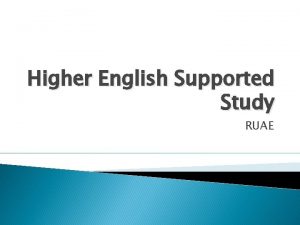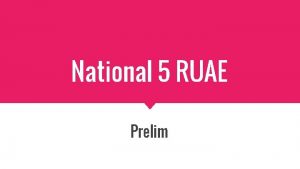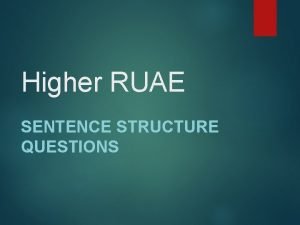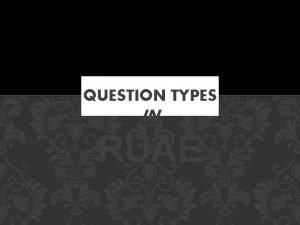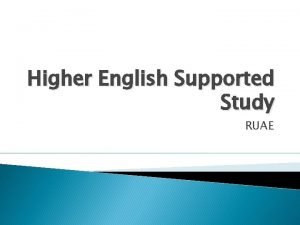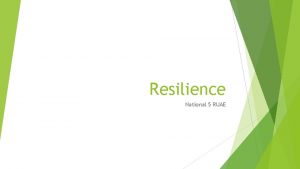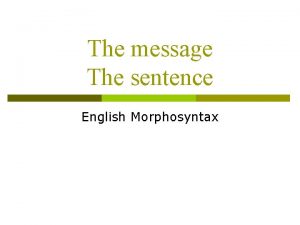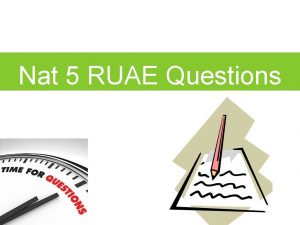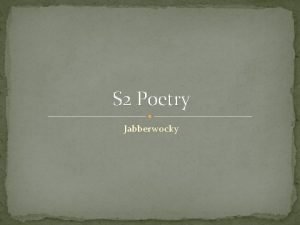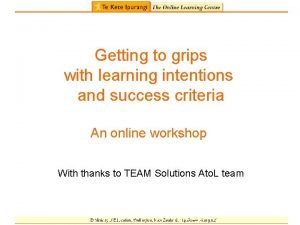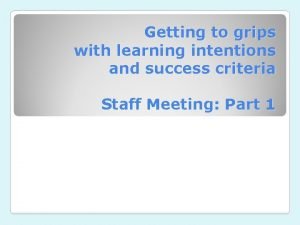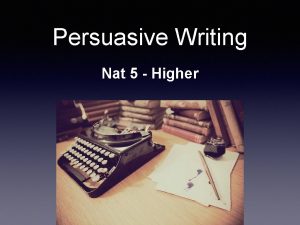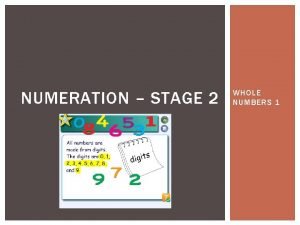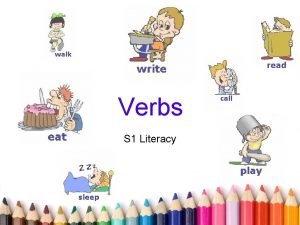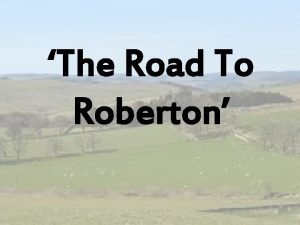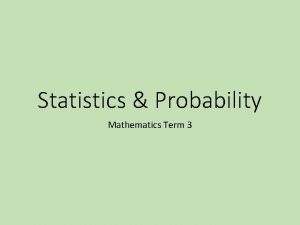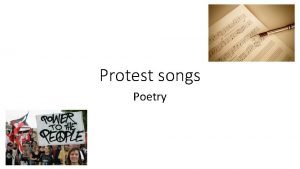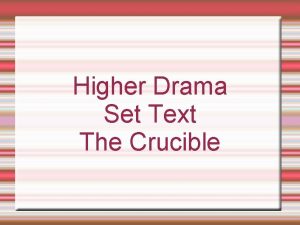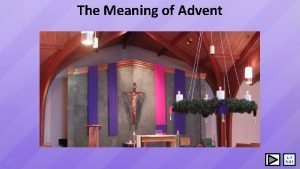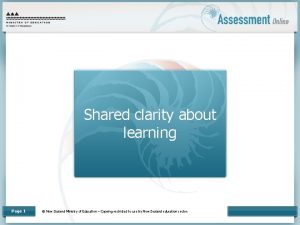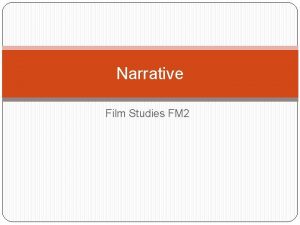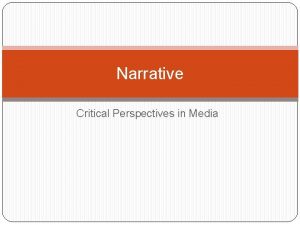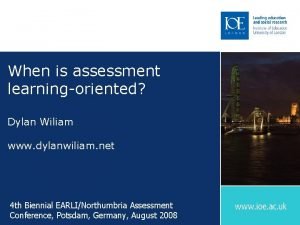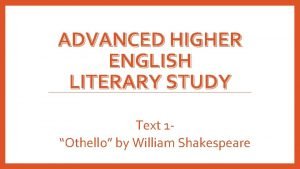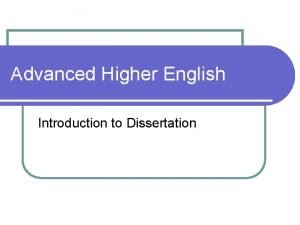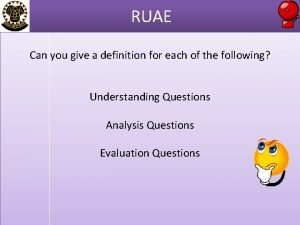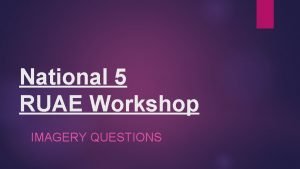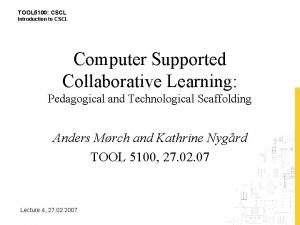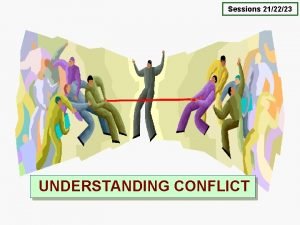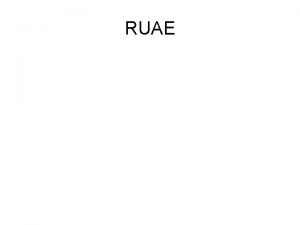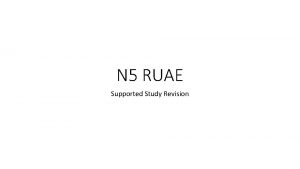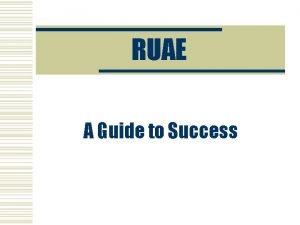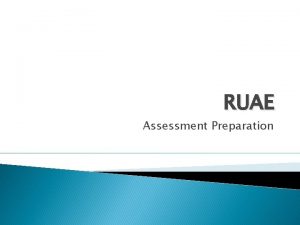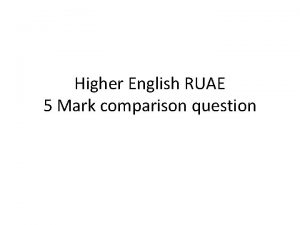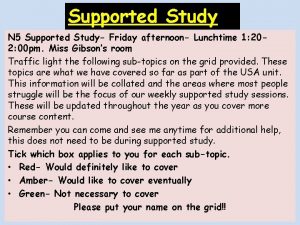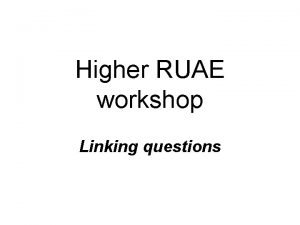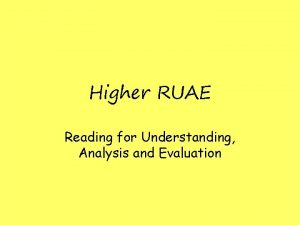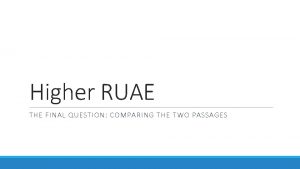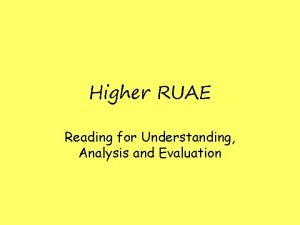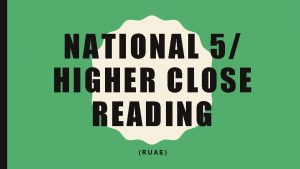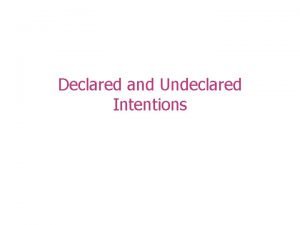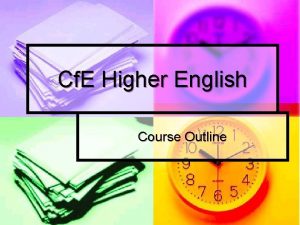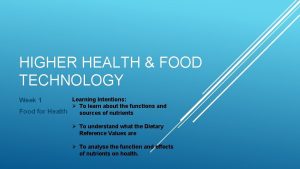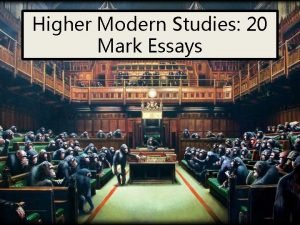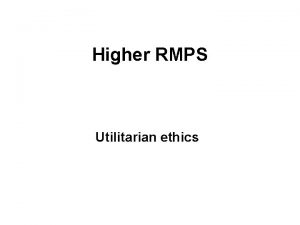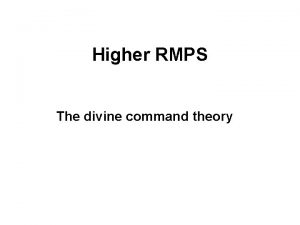Higher English Supported Study RUAE Learning Intentions To







































- Slides: 39

Higher English Supported Study RUAE

Learning Intentions � To find out what we already know about RUAE � To revisit strategies that help you understand the passage � To revise formulas for answering specific question types

What do you know? � Task � With 1 a partner, create a mind-map to show all that you associate with RUAE

First Look at a Passage � When faced with an RUAE passage for the first time, ALWAYS read it all the way through before you start answering questions. � The purpose of this reading is simply to gain a basic understanding of what it is about. � DON’T worry about language, vocabulary or techniques at this stage.

5 -5 -1 Strategy � Task 2 � After reading the passage, try to sum it up in 5 sentences. � Using those 5 sentences, now try to sum it up further in 5 words. � Finally, what 1 word could summarise the who passage?

Highlighting � Using a highlighter is a great tool in an exam – but don’t go daft! � Highlight with focus � Anticipate what the question will be

Past Paper � Task 3 � In groups, look at a specific paragraph and highlight the words/phrases that stand out to you – remember to anticipate! � Now look at the questions – have your selections matched with the demands of the question being asked? � Would you change your approach based on the result? Perhaps only highlight AFTER reading the question?

Question Types Understanding Analysis Evaluation Questions look at WHAT was written and test whether or not you have understood what you have read. Questions get you to think about HOW it was written and how effective the language is. Questions consider WHY the piece was written and whether or not the writer has been successful.

Command words � “Identify” – pick out from the text � “Explain” – show you understand by using your own words � “Summarise” – show you understand a longer section of the text by using your own words and selecting only key/relevant points � “Analyse” – select a technique & explain its effect

Focus on the questions � Task 4 � Look over all of the questions for passage 1. � Can � For you see the command words being used? those that don’t have command words, can you still work out what type of question it is?

The Beating Heart of Language

Word Choice � When answering on word choice you should follow this approach: � “quote” the word � State the connotations (what it suggests) � Explain the effect this has (in relation to the question)

Tasks � Task 5 � ‘Show me board’ word association game � Task 6 � Homework examples

The Beating Heart of Language

Sentence Structure � This can be a difficult area because there are so many different structure techniques � There are different methods you can use to remember the main ones

Llamas! � Really �R �L �L �Q �S �O �P lazy llamas quietly sleep on pillows

Llamas! � Really lazy llamas quietly sleep on pillows � Repetition � Length � Lists � Question � Sentence � Order type � Punctuation

CRIPPLLLS �C �R �I �P �P �L �L �L �S

CRIPPLLLS � Climax � Repetition � Inversion � Parenthesis � Punctuation � Length � Lists � Links � Sentence type

Sentence Structure � To answer a question on sentence structure you should take the following approach: � State the technique being used � “quote” where it being used � Explain why it has been used and what effect is created (FUNCTION & EFFECT)

Sentence Type Revision � � � Statement A simple sentence which includes one point or one fact: eg ‘Orwell creates a turning point in ‘A Hanging’. Effect: impart information / reinforce argument Commands (Imperatives) A sentence which includes a clear instruction: eg “Go read George Orwell’s ‘A hanging’. Effect: to provoke an immediate response / reaction Questions Rhetorical Questions: where there is no answer or the speaker already knows what the answer should be: eg “We don’t kick grannies, do we? ” Effect: provoke agreement / disagreement / humour Minor Sentences where there is no verb

Punctuation A punctuation answer should a) identify the punctuation, then b) state its function and finally show its effect (the question will guide you on this). Eg Show the writer’s language conveys his attitude towards his mother’s shopping habit. Colon introduces a list of all the items she purchased. This shows that he thinks his mother is wasting too much money on things she doesn’t need. Punctuation Function Effect

Punctuation: Revision Colons: introduce - A list, further evidence, an illustration, a quotation Colons: balance - Two opposite ideas in the same sentence Semi-Colons (can do all the above) - Separate out parts of a list Dash - Create a pause / dramatic pause - Introduces further information or additional detail Parenthesis - Created by brackets, double dashes, commas - Add additional information

Lists are usually easy to identify - Look for lots of semi-colons - Or commas and ask yourself whether a list is being created However you need to think about WHY a writer has chosen a list and the EFFECT of the list to his line of thought. Hint – never talk about commas being used to create lists (the Higher marker isn’t going to award marks for commenting on the comma) talk about: the writer uses a list (in line 5 and 6) in order to show that a lot of things were wrong with the shopping centre …

Repetition If in a sentence structure answer you find that you can’t comment on punctuation or a list then consider if words or phrases are being repeated. This is the technique of repetition. Once you have identified the technique you need to identify the function of the repetition. The most likely answers are opposite. Eg Repetition of “spend” to draw attention to the fact that his mother can not stop spending and wasting her money. Function

Word Position Writers like to move key words usually to the beginning and ends of the sentences in order to make them stand out. This technique is called inversion. “Luminous beings are we, not this crude matter. ” You would have expected “We are luminous beings …” but by putting the word ‘Luminous’ to the start of the sentence Yoda draws attention to one of his unique qualities. The effect of inversion is to create effects including drawing attention to something or surprise.

Sentence Length Short sentences are usually easy to spot – but make sure it’s short sentences you’re spotting not short phrases or clauses. Short sentences are usually used either for dramatic impact or to draw attention to one thing. Long sentences usually build up an idea, often to a climax. Writers often like to juxtapose a long sentence with a short sentence to make the short sentence stand out by contrast.

Tasks � Task 7 � Attempt the questions on the practise passage that refer to language � Select an aspect of sentence structure to analyse in your answer

The Beating Heart of Language

Imagery � Pupils sometimes struggle with questions on imagery, yet if you follow the standard formula used to answer them then you should find them much easier. � Imagery is exactly what it says – the techniques used by the writer to help create a picture of what is being described in the text.

What is imagery? � Most common techniques used are: � Simile � Metaphor � Personification � Onomatopoeia (sound of the image) � Alliteration (sound of the image)

Imagery � To answer a question on imagery you should take the following approach: � State the technique being used � “quote” where it being used � State what is being compared to what (or what is being personified as what) � Explain the effect of the comparison, using Just as. . . so to. . .

Imagery Example � “His raven hair was slick with gel and gleamed under the bright lights, like a wet road at midnight”

Imagery Example � “His raven hair was slick with gel and gleamed like a wet road at midnight” � Simile – “His raven hair. . . like a wet road at midnight. ” � His hair is being compared to a wet road. � Just as the road would be dark at midnight with the car headlamps reflecting on the puddles of water on the road, so too his hair would be dark in colour and seem to shine under the lights where it is wet with gel. This has the effect that. .

Imagery � Task 8 � Attempt the questions on the practise passage that refer to language � Select an aspect of imagery to analyse in your answer

Conclusion Questions � You may find the last question on passage 1 asks you to explain how well a certain paragraph acts as a conclusion to the passage as a whole. � In order to do this, your first have to think about the purpose of a conclusion.

What is a conclusion? � The � purpose of a conclusion is: to bring together all of the points/arguments/ideas that have been previously made � to � To express a personal opinion on the subject round off by reaching a final decision (which may not be a concrete answer)

What makes it successful? � It clearly contains phrases or statements that link back to ideas that have already been made and may (or may not) give the writer's own opinion � It uses specific language associated with conclusions, such as “In conclusion”, “To sum up”, “Overall”, “On the whole”, “Moving forward” etc. � It makes use of a technique to enhance the style of the ending and add impact

Conclusion Questions � To answer an effective conclusion question you should take the following approach: � “quote” any phrases that link back to ideas already mentioned earlier � Explain what it links back to and what was previously said � OR � “quote” an example of concluding language or a specific technique � Explain the effect that it creates
 Higher english ruae sentence structure
Higher english ruae sentence structure Ruae question types
Ruae question types Example of sentence structure
Example of sentence structure Ruae question types
Ruae question types Higher english ruae
Higher english ruae Effective conclusion higher english ruae
Effective conclusion higher english ruae Ruae higher english
Ruae higher english Ruae
Ruae Own words questions
Own words questions Poetry learning intentions
Poetry learning intentions Learning intentions examples
Learning intentions examples Example of a learning intention
Example of a learning intention Learning intentions and success criteria examples
Learning intentions and success criteria examples Nat 5 persuasive essay
Nat 5 persuasive essay Write a number in expanded form. 637
Write a number in expanded form. 637 Poetry learning intentions
Poetry learning intentions Fractions learning intentions
Fractions learning intentions Half-turn symmetry
Half-turn symmetry Verb viper
Verb viper Poetry learning intentions
Poetry learning intentions Learning intentions and success criteria for mathematics
Learning intentions and success criteria for mathematics Poetry learning intentions
Poetry learning intentions 8 mark question
8 mark question Reflective phrases
Reflective phrases G acrostic words
G acrostic words The crucible character map
The crucible character map Learning intentions meaning
Learning intentions meaning Absolum duffy
Absolum duffy Narrative learning intentions
Narrative learning intentions Act 2
Act 2 Dylan wiliam learning intentions
Dylan wiliam learning intentions Advanced higher english literary study
Advanced higher english literary study Advanced higher english dissertation
Advanced higher english dissertation Mediocrity meaning
Mediocrity meaning Imagery questions national 5
Imagery questions national 5 Computer supported collaborative learning
Computer supported collaborative learning Cuadro comparativo entre e-learning b-learning y m-learning
Cuadro comparativo entre e-learning b-learning y m-learning Creative intention
Creative intention Conflict of interest in business
Conflict of interest in business Good intentions
Good intentions
